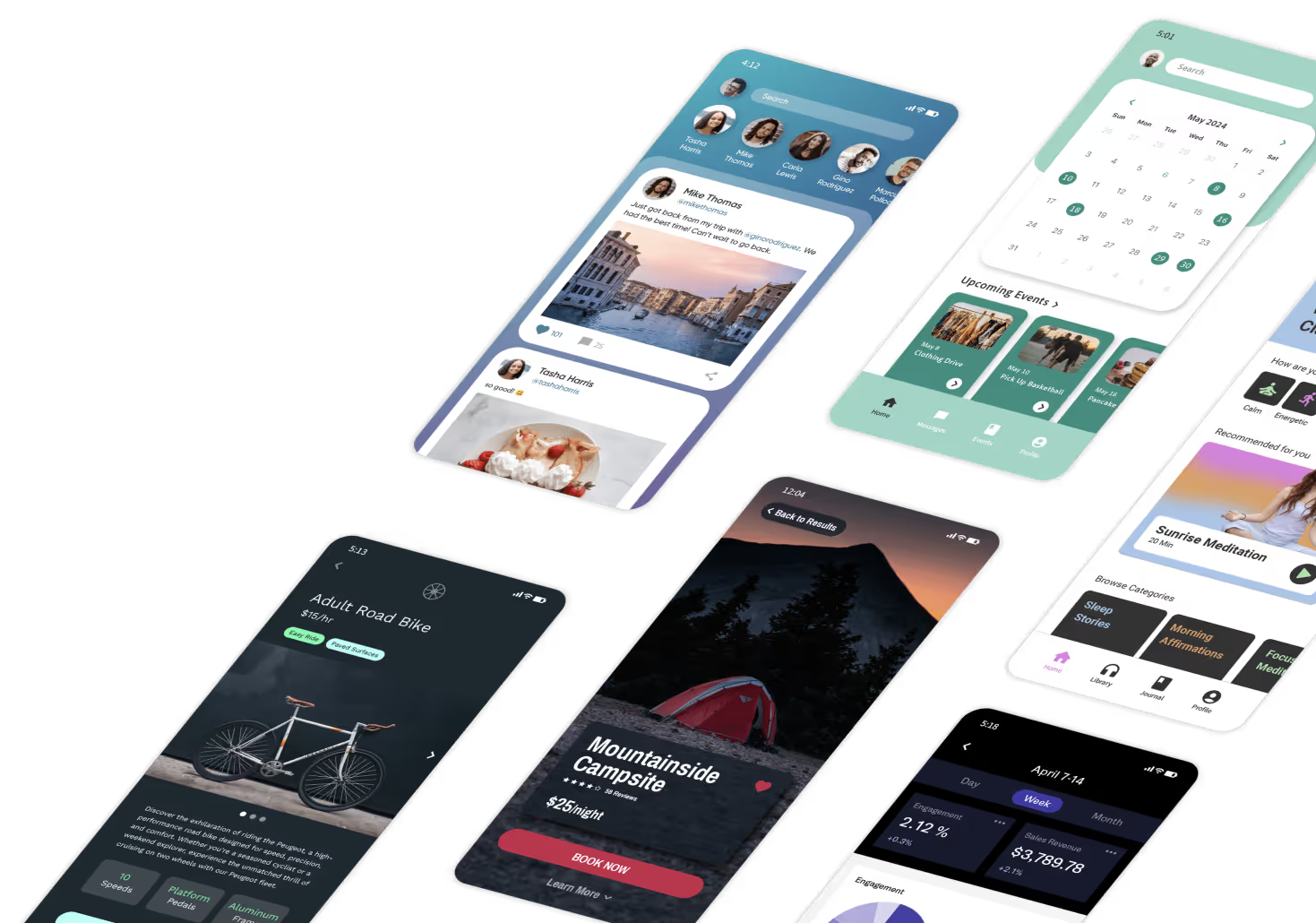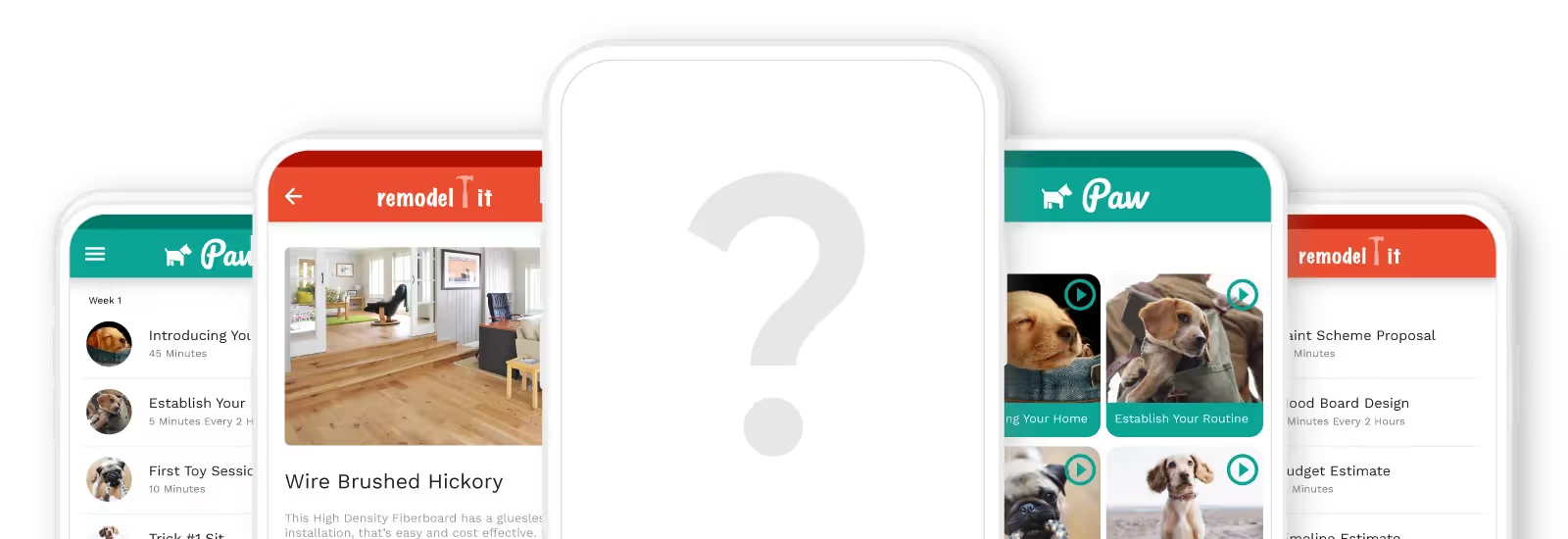
If you’re looking for a PWA (progressive web app) builder, pick Adalo for simplicity, Glide for aesthetics, and Bubble for flexibility.
Read on to learn more about:
- What a PWA is and why they’re useful
- The skills you need to use PWA builders
- Limitations and benefits of PWAs vs native apps
- PWA use cases
- How we chose our top 3 and our list
- Why you should use Adalo for your PWA
Let’s now walk you through what PWAs are and their benefits.
What Is a PWA?
A Progressive Web App (or PWA) is software that looks and feels like a proper, native mobile app but is actually a sophisticated website that can work seamlessly across mobile and desktop views.
One key advantage of a PWA is that it can be downloaded to a phone without going through an app store. Users will get your PWA by following a link or scanning a QR code, and it will appear as an icon on their screen as if they downloaded it from the Apple App Store and Google Play Store.
This means you can skip the approval process (and the cost) for having your app listed on Apple’s iOS App Store or Google’s Play Store.
Being a website under the hood, they also have all the benefits you would expect from a website: They can be found on Google if your SEO is up to scratch, you can link to different
pages in the PWA, and they can be updated on the fly without your users having to download an update — or Tim Cook giving you the go-ahead.
Advantages of PWAs
Unlike normal websites, PWAs can also take advantage of several popular features normally only found in native apps. For example, you can send push notifications to your PWA users, they can be saved to a user’s home screen alongside their other apps, and they can even work offline by using “cached” (saved) content just like a normal iPhone or Android app.
Perhaps the most significant benefit of all is that you can automatically turn your website into a PWA. Whether you’ve built it on a platform like Webflow or Wix, or painstakingly hand-coded it with HTML, PWA technology usually only takes a few steps to set up. You don’t have to build an app completely from scratch.
Building a PWA: Do I Need Coding Skills?
The short answer is no. You don’t need any coding skills or technical knowledge about backend logic and databases to create your own PWA. It’s the mid-2020s, and several no-code app building platforms are available for anyone to build a PWA.
So, what is a no-code app builder? It’s a software platform that lets you breathe life into any PWA idea without using coding. Instead of entering line after line of a programming language, a no-code app builder uses a drag-and-drop interface, templates, and other premade components.
Most no-code app builders let you choose a template that matches your PWA idea. For instance, many app builders have templates for internal business tools, booking platforms, social media, and much more.
Then, customize each template using premade components like forms, buttons, and elements, placing them wherever you wish. Change the colors to match your needs, slap on your brand logo to match your profession, and then allow folks to download it. It’s that easy.
The bottom line is this: If you can open an email account, you have enough skills to learn a no-code PWA app builder.
Limitations of PWAs vs Native Apps
Sounds perfect, right? There’s a catch that might make you want to look for a native app builder instead.
First of all, the benefit of not requiring app store approval is a double-edged sword. Your users also won’t be able to find your app on the app store. This cuts you off from two distribution platforms with billions of users. It would be like banning yourself from advertising on Facebook and Google.
Secondly, you’ll need a native app if you want to take advantage of mobile phone capabilities like cameras, sensors, geolocation, and security (e.g., fingerprint scanning and Face ID). While PWAs can access some of this functionality in a restricted fashion, only native apps can fully harness the power and features found on any Apple or Android device.
Performance is also a concern. Since they’re websites, PWAs load just like a website — it’s not uncommon for your user to click a button and be met with a blank, white page for 30 seconds. Native apps solve this problem and take full advantage of the full processing power of your users’ devices.
One last thing: Outside of tech circles, most people don’t know what a PWA is. They'll look in the app store if you tell them to look for your app. If you tell them to save your website to the home screen, they’ll need guidance on how to do that.
This is perhaps the largest barrier to using a PWA. As much as we techie folk want to push PWAs, they haven’t quite caught on yet.
Why Choose a PWA Over a Native App?
While publishing a native mobile app has its own unique benefits, there are specific reasons and use cases that actually favor creating PWAs over native mobile apps:
- Your time is limited: We can’t emphasize this enough — publishing an app to the Apple App Store and Google Play Store takes time and money. You’ll need to pass both iOS and Google’s lengthy publishing processes, which entail filling out forms, paying fees, hiring out testers, and many other steps. This can potentially tack on several months, which may be a deal breaker if you need your app yesterday.
- You need a simple app: Do you just want to build a booking and payment app for your restaurant that users can download to their phones or access on the web? In this case, going through the app-store publishing process could be overkill. A PWA is the best option, as you can release your simple app to your clients in no time.
- You’re building an internal business tool with a restricted user base: Ultimately, there are very few reasons to publish a private business app to the Apple App Store or Google Play Store. This is because only folks within your organization, clients, or partners will access your app, and they’ll do so by logging into private portals.
Now that you know why you should create a PWA over a native mobile app, let’s quickly run through a few PWA use cases.
Best Use Cases for Progressive Web Apps
Here are a few popular use cases where building a PWA is ideal:
- E-commerce stores for mobile users: A PWA makes life easy if you’re selling products. First-time users can access your store with ease directly from the web, while your loyal customers can download your PWA directly to their phones for quick access — no need to take the time for app store publishing.
- Content-heavy apps: If you’re releasing periodic content like news articles, market analyses, or other information accessible to subscribers only, go for a PWA. Just like with e-commerce platforms, users can first visit your app and get a taste of your content via the web and then download your PWA to their devices once they become subscribers.
- Internal business apps, tools, and software: Need to make a KPI tracker to determine which marketing campaigns stick? How about a revenue analysis app that integrates with your accounting software? Perhaps you need a portal for clients to log in and view their orders and account information.
Because these internal business tools are only used by your partners or team members within your organization, creating a PWA is ideal, as these tools won’t need to be available to the public.
Let’s now examine some of the steps you can take to find the best PWA for your needs.
What To Look For in a Progressive Web App Builder
Here are a few pointers to consider before you start creating your PWA:
- Do you already have a web app built? You’ll want a PWA builder which integrates with the platform you used to build your website. You’ll want it to work quickly and out of the box, so you won’t have to worry about hitting any speedbumps along the way.
- Are you building from scratch? Then you’re actually looking for a no-code mobile app builder that is capable of building PWAs. You’ll be able to kickstart your app-building by beginning with templates, dragging over elements, and more.
- Easy deployment: Some Progressive Web App builders require you to actually code in PWA features. If “service workers” makes you think of retail and “routing” gets you all fired up, this is probably not what you’re looking for. Instead, seek out 1-click PWA conversion, which allows you to get your app published to the web in no time.
- Push notifications: One of the most important features of any app, native or PWA, is to send push notifications to the app’s users. For instance, if you have a booking app, you can inform clients that their table is available earlier, which can be great for business.
Look for a platform that makes this easy and straightforward and provides a simple interface for configuring and scheduling notifications.
The 3 Best Progressive Web App Builders
- Adalo, best to build and deploy a PWA and native app
- Glide, best if you want sleek aesthetics
- Bubble, best if you need flexibility
#1 Adalo, Best to Build And Deploy a PWA and Native App

Adalo is a no-code mobile app and PWA builder, that allows you to build one app and publish it as a native app, web app, and a progressive web app. This gives you the best of both worlds, allowing you to publish to the app stores if you want to in the future.
Ideal Users
For several years, we’ve recommended Adalo to freelancers, entrepreneurs, and small and medium business owners more than any other app builder. That’s because Adalo’s easy enough to use right out of the box, yet it’s robust enough to bring any app idea to life.
Features
- Adalo integrates with backends like Xano and Airtable, but if you don’t use these services, you can create your backend with Adalo’s backend builder, making it accessible to folks with their own backends and those without.
- The platform is packed with power yet stupidly simple to get the hang of. You’ll be able to start learning Adalo right out of the box, so you won’t need to spend much time sifting through help documents or watching tutorials.
- Need to integrate with a third-party application like QuickBooks or MailChimp? Adalo’s got you covered with over 1,000 integrations, meaning you can transfer data between apps and set up automations.
Pricing
Get started with Adalo for only $45/month (billed monthly).
The Bottom Line
No matter what kind of PWA you want — be it a scheduling app for your salon or an internal dashboard for your revenue KPIs — Adalo has the tools, power, and features you need to make a PWA that you can also convert to a native mobile app with the simple push of a button.
#2 Glide, Best If You Want Sleek Aesthetics

Prioritizing aesthetics, Glide is a no-code web app builder that offers some of the sleekest templates and elements, ensuring that your PWA can stand out amongst the crowd.
Ideal Users
Glide is an excellent PWA builder for internal business tools. While you’ll need to get started with a database, Glide has its own built-in database creator, so you won’t need to enlist the services of a third-party database like Airtable or Google Sheets.
Features
- Glide offers a premium AI tool. The AI will allow your PWA to summarize documents, describe pictures, and much more, bolstering its functionality.
- You won’t have a difficult time getting your no-code PWA development started with Glide — you’ll find over 100 pre-made templates that pass the eye test, which you can customize to create your very own app.
- You’ll be able to update your PWA several times monthly, allowing you to keep your app up-to-date and bug-free and boosting its user experience.
Pricing
Get started at $86/month (billed monthly) and make up to 3 apps. If you need to create more than 3, check out Glide’s $249/month (billed version) version and build as many PWAs as you can shake a stick at.
Like Glide but don’t want to build an app yourself? Just outsource your app-building to a Glide expert, starting at $2,000 per PWA.
The Bottom Line
If you prioritize aesthetics, need to create multiple apps, and would like to implement updates yourself, Glide is a great PWA builder for your shortlist.
#3 Bubble, Best If You Need Flexibility

Originally released over a decade ago, Bubble is one of the OG PWA builders, offering enough power and flexibility to create nearly any app for any business, regardless of size, that you can imagine.
Ideal Users
While there’s almost no limit to the type of PWA that you can create, Bubble comes with one major drawback: It has one of the steepest learning curves in the no-code space. So, you’ll need to dedicate a few months to learning the app-building interface.
But once you get over the hump, you’ll be able to create nearly any kind of app for any sort of business, be it your own freelancing gig or a behemoth Fortune 500.
Features
- Concerned about hackers and other nefarious folks? No need to worry when you choose Bubble — it provides Fort Knox-style security measures to keep these clowns out. You’ll also be able to run security scans to shore up weak points, set 2-factor authentication, and much more.
- Bubble provides the most robust and thriving ecosystems in the industry. You’ll find ample help documents, tutorials, and much more so you can navigate that tough learning curve mostly headache-free.
- You can select from over 1,000 free and paid templates to start your app-building, and you’ll also get access to over 3,000 third-party plugins, such as QR scanners, digital signature features, and more, to power up your app.
Pricing
Bubble starts at $32/month (billed monthly), letting you make your own branded app with access to Bubble’s powerful API, which allows you to automate workflows and transfer data from other accounts right to your PWA.
If you need more space or are working with a partner, check out Bubble’s $134/month (billed monthly) version, giving you up to 100 GB of storage and allowing for an extra app editor.
The Bottom Line
For folks who need extra power and flexibility to create their PWAs, and have enough spare time to learn the building interface, Bubble is a great option.
'{{rich-cta}}'
Next Steps: Adalo, the Perfect PWA Builder
We believe that the best apps don’t have borders. Users should be able to use your app wherever and however they like, whether on the web, directly from the app store, or downloaded as a PWA onto their device.
Adalo is one of the top no-code app builders which not only lets you build your app from scratch but will let you publish it to the app stores, the web, and as a PWA. While other platforms let you build PWAs directly, none give you all the freedom or benefits of publishing natively.














